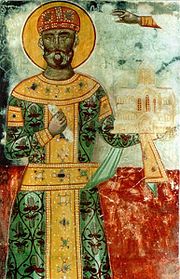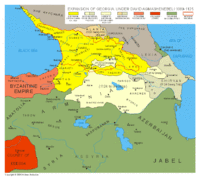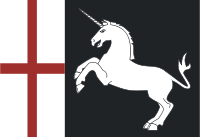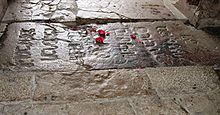- David IV of Georgia
-
David IV
დავით IVKing of Kings of Georgia 
King of Georgia Reign 1089–1125 Predecessor George II Successor Demetrius I Spouse Rusudan of Armenia
Guranduht of the KipchaksIssue Demetrius I
Vakhtang
George
Tamar
Katay
TamarDynasty Bagrationi Father George II of Georgia Mother Helena Born 1073
KutaisiDied 24 January 1125
TbilisiBurial Gelati Monastery Religion Georgian Orthodox Church David IV "the Builder", also known as David II[1] (Georgian: დავით აღმაშენებელი, Davit Aghmashenebeli) (1073 – January 24, 1125), of the Bagrationi dynasty, was a king of Georgia from 1089 until his death in 1125.[2]
Popularly considered to be the greatest and most successful Georgian ruler in history, he succeeded in driving the Seljuk Turks out of the country, winning the major Battle of Didgori in 1121. His reforms of the army and administration enabled him to reunite the country and bring most of the lands of the Caucasus under Georgia’s control. A friend of the church and a notable promoter of Christian culture, he was canonized by the Georgian Orthodox Church.
Contents
Early life
The only son of King George II (1072–1089) by his wife Helena, he was born in Kutaisi, western Georgia in 1073. David was raised during one of the darkest chapters of Georgian history, amidst the strife of the so-called Great Turkish Onslaught (didi turkoba) when the Seljuk tribes began massive migrations to the southern Caucasus. King Giorgi II was unable to cope with the problem, and in a bloodless coup in 1089, he was forced to resign in favor of his 16-year-old son.
David's revival of the Georgian State
Despite his age, he was actively involved in Georgia’s political life. Backed by his tutor and an influential churchman George of Chqondidi, David IV pursued a purposeful policy, taking no unconsidered step. He was determined to bring order to the land, bridle the unsubmissive secular and ecclesiastic feudal lords, centralize the state administration, form a new type of army that would stand up better to the Seljuk Turkish military organization, and then go over to a methodical offensive with the aim of expelling the Seljuks first from Georgia and then from the whole Caucasus. Between 1089–1100, King David organized small detachments of his loyal troops to restore order and destroy isolated enemy troops. He began the resettlement of devastated regions and helped to revive major cities. Encouraged by his success, but more importantly the beginning of the Crusades in Palestine, he ceased payment of the annual contribution to the Seljuks and put an end to their seasonal migration to Georgia. In 1101, King David captured the fortress of Zedazeni, a strategic point in his struggle for Kakheti and Hereti, and within the next three years he liberated most of eastern Georgia.
In 1093, he arrested the powerful feudal lord Liparit Baghvashi, a long-time enemy of the Georgian crown, and expelled him from Georgia (1094). After the death of Liparit’s son Rati, David abolished their duchy of Kldekari in 1103.
He slowly pushed the Seljuk Turks out of the country, recovering more and more land from them as they were now forced to focus not only on the Georgians but the newly begun Crusades in the eastern Mediterranean.[3] By 1099 David IV's power was considerable enough that he was able to refuse paying tribute to the Turks. By that time, he also rejected a Byzantine title of panhypersebastos [4] thus indicating that Georgia would deal with the Byzantine Empire only on a parity basis.
In 1103 a major ecclesiastical congress known as the Ruis-Urbnisi Synod was held at the monasteries of Ruisi and Urbnisi. David succeeded in removing oppositionist bishops, and combined two offices: courtier’s (Mtzignobartukhutsesi, i.e. Chief Secretary) and clerical (Bishop of Tchqondidi) into a single institution of Tchqondidel-Mtzignobartukhutsesi corresponding roughly to the post of prime minister.
Next year, David’s supporters in the eastern Georgian province of Kakheti captured the local king Aghsartan II (1102–1104), a loyal tributary of the Seljuk Sultan, and reunited the area with the rest of Georgia.
Military campaigns
Following the annexation of Kakheti, in 1105, David routed a Seljuk punitive force at the Battle of Ertzukhi, leading to momentum that helped him to secure the key fortresses of Samshvilde, Rustavi, Gishi, and Lorri between 1110 and 1118.
Problems began to crop up for David now. His population, having been at war for the better part of twenty years, needed to be allowed to become productive again. Also, his nobles were still making problems for him, along with the city of Tbilisi which still could not be liberated from Arab grasp. Again David was forced to solve these problems before he could continue the reclamation of his nation and people. For this purpose, David IV radically reformed his military. He resettled a Kipchak tribe of 14.000 families from the Northern Caucasus in Georgia in 1118–1120. Every Georgian and Kipchak family was obliged to provide one soldier with a horse and weapons. This 56.000 men strong army was entirely dependent on the King. Kipchaks were settled in different regions of Georgia. Some were settled in Inner Kartli province, others were given lands along the border. They were quickly assimilated into Georgian society.
In 1120 David IV moved to western Georgia and, when the Turks began pillaging Georgian lands, he suddenly attacked them. Only an insignificant Seljuk force escaped. King David then entered the neighbouring Shirvan and took the town of Qabala.
In the winter of 1120–1121 the Georgian troops successfully attacked the Seljuk settlements on the eastern and southwestern approaches to the Transcaucasus.
Muslim powers became increasingly concerned about the rapid rise of a Christian state in southern Caucasia. In 1121, Sultan Mahmud b. Muhammad (1118–1131) declared a holy war on Georgia and rallied a large coalition of Muslim states led by the Artuqid Najm al-din El-ğazi and Toğrul b. Muhammad. The size of the Muslim army is still a matter of debate with numbers ranging from fantastic 600,000 men (Walter the Chancellor’s Bella Antiochena, Matthew of Edessa) to 400,000 (Smbat Sparapet’s Chronicle) to modern Georgian estimates of 250,000–400,000 men. All sources agree that the Muslim powers gathered an army that was far much larger than the Georgian force of 56,000 men. However, August 12, 1121, King David routed the enemy army on the fields of Didgori, achieving what is often considered the greatest military success in Georgian history. The victory at Didgori signaled the emergence of Georgia as a great military power and shifted the regional balance in favor of Georgian cultural and political supremacy.
Following his success, King David captured Tbilisi, the last Muslim enclave remaining from the Arab occupation, in 1122 and moved the Georgian capital there. A well-educated man, he preached tolerance and acceptance of other religions, abrogated taxes and services for the Muslims and Jews, and protected the Sufis and Muslim scholars. In 1123, David’s army liberated Dmanisi, the last Seljuk stronghold in southern Georgia. In 1124, David finally conquered Shirvan and took the Armenian city of Ani from the Muslim Emirs, thus expanding the borders of his kingdom to the Araxes basin. Armenians met him as a liberator providing some auxiliary force for his army. It was when the important component of "Sword of the Messiah" appeared in the title of David the Builder. It is engraved on a copper coin of David's day:
“ King of Kings, David, son of George, Sword of the Messiah. ” Humane treatment of the Muslim population, as well as the representatives of other religions and cultures, set a standard for tolerance in his multiethnic kingdom. It was a hallmark not only for his enlightened reign, but for all of Georgian history and culture.
David the Builder died on January 24, 1125, and upon his death, King David was, as he had ordered, buried under the stone inside the main gatehouse of the Gelati Monastery so that anyone coming to his beloved Gelati Academy stepped on his tomb first, a humble gesture for a great man. He had three children, the son Demetrius, who succeeded him and continued his father's victorious reign; and two daughters, Tamar, who was married to the Shirwan Shah Akhsitan (Aghsartan in Georgian), and Kata (Katai), married to Isaakios Comnenus, the son of the Byzantine Emperor Alexius I Comnenus. Beside his political and military skills, King David earned fame as a writer, composing Galobani sinanulisani (Hymns of Repentance, c. 1120), a powerful work of emotional free-verse psalms, which reveal the king’s humility and religious zeal.
Cultural life
 Gelati Monastery fresco of King David, 12th century
Gelati Monastery fresco of King David, 12th century
King David the Builder gave close attention to the education of his people. The king selected children who were sent to the Byzantine Empire "so that they be taught languages and bring home translations made by them there". Many of them later became well-known scholars.
At the time of David the Builder there were quite a few schools and academies in Georgia, among which Gelati occupies a special place. King David's historian calls Gelati Academy
“ a second Jerusalem of all the East for learning of all that is of value, for the teaching of knowledge - a second Athens, far exceeding the first in divine law, a canon for all ecclesiastical splendors. ” Besides Gelati there also were other cultural-enlightenment and scholarly centers in Georgia at that time, i.e. the Academy of Ikalto.
David himself composed, c. 1120, "Hymns of Repentance" (გალობანი სინანულისანი, galobani sinanulisani), a sequence of eight free-verse psalms, with each hymn having its own intricate and subtle stanza form. For all their Christianity, cult of the Mother of God, and the king’s emotional repentance of his sins, David sees himself as reincarnating the Biblical David, with a similar relationship to God and to his people. His hymns also share the idealistic zeal of the contemporaneous European crusaders to whom David was a natural ally in his struggle against the Seljuks.[5]
Family
Marriages
- Rusudan, an Armenian princess (divorced in 1107)
- Gurandukht, daughter of the Kipchak chief Otrok (ca. 1107)
Issue
- Demetrius I
- Prince Vakhtang (Tsuata)
- Prince George (From Rusudan)
- Princess Tamar, who married Abul Muzaffar Manuchahr II, Shirvanshah (d. ca 1154), and became a nun in widowhood.
- Princess Katay, who has been theorized to be the same person as Irene who married the Byzantine prince Isaakios Comnenus Sebastocrator.
- Princess Tamar who was married to Prince Jadaros of Ossetia
Burial
A tombstone at the Gelati monastery, bearing a Georgian inscription in the asomtavruli script, has traditionally been considered to be that of David IV. Although there are no clear and reliable indications that David was indeed buried in Gelati and that the present epitaph is his, this popular belief had already been established by the mid-19th as evidenced by the French scholar Marie-Félicité Brosset who published his study of the Georgian history between 1848 and 1858. The epitaph, modeled on the Psalm 131 (132), 14, reads: "Christ! This is my resting place for eternity. It pleases me; here I shall dwell."[6]
Legacy
David the Builder’s epoch greatly influenced the national perception of the Georgians. They are still proud of David’s victories and dream of his glorious reign.
The nation’s current flag is based on David’s standard. The Order of David the Builder is one of the most prestigious decorations awarded by Georgia.
After being elected President of Georgia, Georgia’s current leader Mikheil Saakashvili took an oath at David the Builder’s tomb at Gelati Monastery on the day of his inauguration on January 25, 2004. Mikheil Saakashvili said it was a symbol of his dedication to follow in David's footsteps, who brought unity and prosperity to Georgia.
Ancestry
Ancestors of David IV of Georgia16. Bagrat III of Georgia 8. George I of Georgia 17. Martha 4. Bagrat IV of Georgia 18. John-Senekerim II Artsruni, King of Vaspurakan 9. Mariam of Vaspurakan 19. Khashush Bagratuni of Ani 2. George II of Georgia 5. Borena of Alania 1. David IV of Georgia 3. Helena See also
Notes and references
- ^ Britannica online
- ^ Georgia in the Developed Feudal Period (XI-the first quarter of the XIII c.) www.parliament.ge/ Retrieved 13 August 2006.
- ^ Fighting against the Seljuks, Georgia and the Crusaders developed fairly friendly relations. A 13th century anonymous Georgian author (conventionally known as the First Chronicler of Queen Tamar) as well as Abul-Faraj gives a version, though unproven otherwise, about the participation of a Georgian auxiliary force in the Siege of Jerusalem (1099). Some 300 Crusaders (known to the Georgians as Franks) are also known to take part in the famous Battle of Didgori (1121). King Baldwin II of Jerusalem is said by the historian Ioane Bagrationi, who refers to unknown medieval sources, to have visited incognito David IV’s court
- ^ Since the Bagrationi dynasty established the Tao-Klarjeti principality under the Byzantine protectorate in 813, representatives of the dynasty had been granted various Byzantine titles such as kouropalates, magistros, sebastos, etc. David was the last Georgian monarch to wear a Byzantine title.
- ^ Donald Rayfield, "Davit II", in: Robert B. Pynsent, S. I. Kanikova (1993), Reader's Encyclopedia of Eastern European Literature, p. 82. HarperCollins, ISBN 0-06-270007-3.
- ^ Jost Gippert / Manana Tandashvili (2002), The Epitaph of David the Builder. Gelati Academy of Sciences Project: Old Georgian texts from the Gelati school (TITUS project). Accessed June 19, 2011.
- Lordkipanidze, Mariam (1987). Georgia in the 11th–12th centuries. Tbilisi. pp. 80–118.
- Grand Larousse encyclopédique. 5. Paris. 1962. pp. 452–453. (French)
- Enciclopedia Italiana. Rome. 1950. pp. 641–643. (Italian)
External links
- The Bagrationi Royal Dynasty of Georgia, by Dr. Levan Z. Urushadze (Tbilisi, Georgia), Retrieved 13 August 2006.
- Agmashenebeli.com - David IV `the Builder' (King) of GEORGIA
Preceded by
George IIKing of Georgia
1089–1125Succeeded by
Demetrius ICategories:- Kings of Georgia (country)
- Bagrationi dynasty
- Saints of Georgia (country)
- People from Kutaisi
- Orthodox monarchs
- 1073 births
- 1125 deaths
- 12th-century Christian saints
Wikimedia Foundation. 2010.





